Sending out cold emails is a crucial part of selling, and mastering cold email best practices is key to making your emails stand out in a crammed inbox.
We get it, seriously. The struggle is real for us, too (we sell to sellers).
So we decided to take matters into our own hands.
We took our SDR Manager Jack Wauson’s experiences and insights, combined them with Jason Bay’s unmatched expertise, and hosted our recent webinar, “Win the Inbox,” (which this blog, focusing on b2b cold email best practices, is based on).
We extracted all the most valuable elements of our webinar for this post and put together 16 proven cold email best practices and tactics that will help get your emails the attention they deserve.
The goal? To increase your reply rates.
|
Here's what's covered in this post: |
Cold email subject line tactics to stand out in a crowded inbox
Subject lines are the gatekeepers of cold emails.
Use the wrong secret code words, and you’re not getting in.
Here are a few cold email best practices and tactics Jason and Jack recommend when it comes to crafting your subject lines.
1. Write your email first, then your subject line
Think of your email as the movie, and the subject line as the movie trailer. There’s no way you can create the latter without the former.
As Jason put it, “If you saw a trailer, and it was completely unrelated to the movie, you might be pretty mad. Or the opposite can happen where the trailer might do the movie a disservice and not get you excited about watching it.”
Moral of the story: Write your email first, and then pick out things from the email and put it in the subject line.
2. Avoid using a call to action in your subject line
If you include a call to action (CTA) in your subject line—for example, “Want to boost reply rates?”—, that immediately screams COLD EMAIL.
People’s inboxes are already filled to the brim with hundreds of emails, and most of us have developed an internal “spam” detector over time. So if your email comes off as too sales-y from the get-go, you better believe it’ll end up in the trash.
Here are a few other CTAs to AVOID using in your cold email subject lines:
- Quick meeting?
- Call tomorrow?
- Looking to [positive outcome]?
- Need help with [pain point]?
3. Craft subject lines that look like internal emails
What we mean by that is to write your cold email subject line to make it look like an email that an internal employee would send to another employee.
Here are a few examples of internal-looking subject lines that Jason Bay shared:
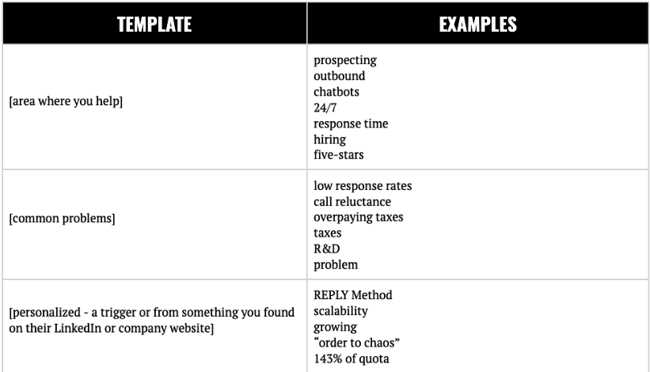
Source: Jason Bay, Outbound Squad
| You can read our blog on 95 sales prospecting email subject lines for more examples of internal-looking ones. |
4. Avoid using the recipient’s name in your subject line
Listen, we know. This was all the hype a few years ago. This used to be enough for your email to be considered personalized.
But using the recipient’s name in the subject line is a thing of the past. In fact, it’ll have the opposite effect and trigger your prospect’s internal spam filter (yet again).
The ultimate turnoff for recipients? Using their first name combined with a CTA in the subject line.
Here are examples of “personalization” you need to AVOID using:
- {First name}, wanna chat?
- {First name}, want to solve [pain point]?
- {First Name}, [literally anything]
Cold email opening line best practices that hook the reader
A big part of what drives open rates is the first line of the email, otherwise known as the preview text. In this section, we'll delve into cold email opening line best practices and how they significantly contribute to reader engagement.
5. Connect the subject line to the opening line
Here’s a great example of how to tie your subject line to your opening line, courtesy of outbound expert, you guessed it, Jason:
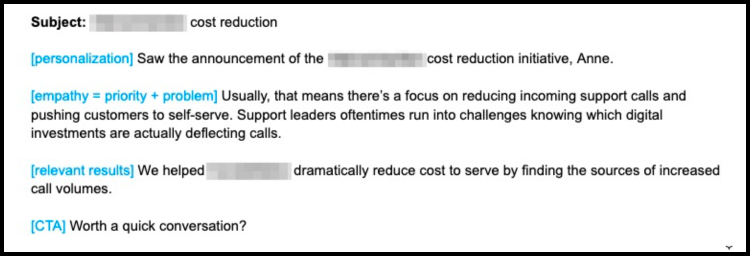
The subject line (which looks internal) and the opening line both reference the same thing, in this case, a cost reduction initiative that the recipient’s company is undertaking.
Another example of a great opening line that relates to the subject line is this one sent to Mixmax’s Content Marketing Manager, Rita Melkonian (surprise, that’s me!):
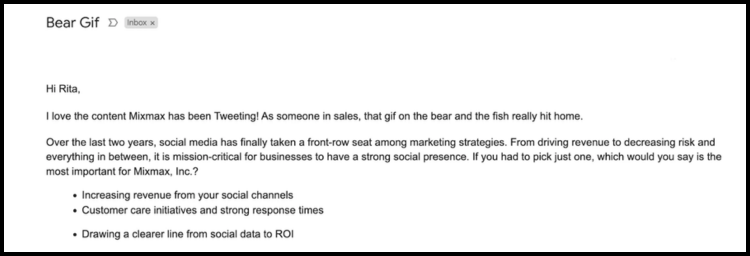
In this email, the sales rep is referencing a social post that the prospect published, and it’s not just random personalization because the service the seller is offering is related to social media.
Bingo bango. Nailed it.
6. Use their first name at the end of the opening line
The title pretty much says it all. Instead of using the recipient’s first name at the beginning of the opening line, throw it at the end.
If you look at the email example we posted earlier from Jason, you’ll notice that’s exactly the tactic the sender used when writing the opening line. To save you some precious scrolling time, here it is again:
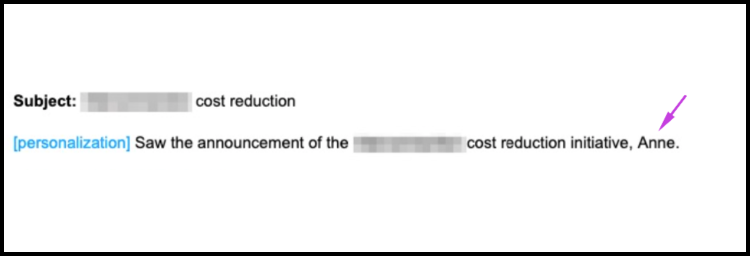
A super simple detail that’s worth testing in your next cold email outreach campaign.
7. Make it about them, not you
This tactic is key. And it doesn’t just apply to the opening line of your cold email, it applies to the ENTIRE email.
Stop. Talking. About. Yourself. (or your product/service).
The opening line has to focus on the prospect. And it can be as simple as including an observation about them like, “Your team seems to be focusing on video content, particularly the Ask a Leader interview series.”
100% focus on the recipient, calling out an observation that hooks the reader. 10/10.
| P.S. We actually do have that series where we interview sales experts. You can check it out here. |
8. Eliminate the pleasantries
No more small talk in the opening line.
Here’s a list of fluff to AVOID using:
- Hope this email finds you well.
- Hope you’re doing well.
- How’s it going?
- Hope you’re having a good week so far.
These lines are just taking up precious real estate in your email, not to mention wasting your preview text.
Body copy tactics that keep the recipient engaged
Sometimes it’s easy to get carried away with flowery language and elegant prose (like this), but don’t be that person—clear and straightforward beats Shakespearean every day of the week.
Keep the body of your email short, straightforward, and engaging. The key is to reduce friction.
Follow these cold email best practices to learn how to keep the reader engaged.
9. Make the body copy reader-friendly
People are skimming through your email. Always remember that. So make your email easily skimmable.
Some quick and dirty formatting tips to help the reader out:
- Use bullet points, esp. when mentioning value props
- Use bolded words to emphasize important aspects of the email
- Break up your paragraphs into 1-2 sentences
- Use short sentences to break down your message into easily digestible chunks
- Don’t include more than one link
- Focus on one CTA only (more on that later)
Here's an example of an email makeover:
Before
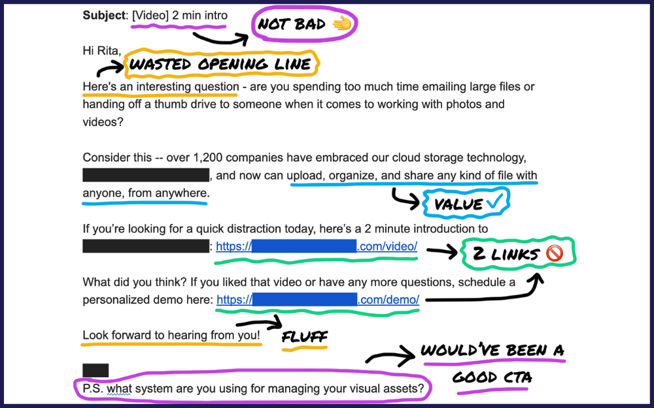
After
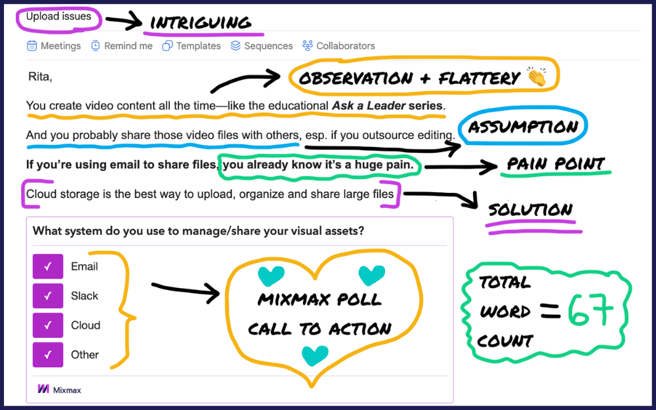
See the full makeover post on LinkedIn.
10. Avoid talking about/listing features
Look, everyone has cool features they want to talk about. But your prospect doesn’t care about those. They care about the end result (aka how their problem will be solved).
So please, PLEASE, don’t copy and paste your feature list in your cold email outreach.
Instead, talk about your prospect's problems and focus on value props.
Here’s an example of good value props:
“With Mixmax, you can:
- Avoid having duplicate data in your CRM
- Increase meetings booked by 57%
- Save your team time by automating follow-ups”
Example of kicka$$ cold email body copy

11. Use social proof in your follow-up email
Social proof is one of the most underutilized elements in sales.
Do you have case studies or testimonials that talk about how your product/service helped a customer overcome a problem?
If the answer is yes, USE IT.
If the answer is no, ask your marketing team to write one and then USE IT.
People like hearing success stories. They want to hear about how someone in their position benefited from whatever you’re offering.
As our SDR Manager Jack Wauson mentions in the webinar, “Everyone likes being told a good story of how someone was struggling and how you came in and saved them. How you helped them go from Zero to Hero. I’m sure all of you have customer stories out there. Use those.”
Call to action best practices that increase reply rates
One of the more underrated parts of the email is how you end it. But the funny thing is, it’s one of the most important parts of your email, because it’s what your recipient will look at to figure out what you expect from them.
We taught you how to nail your opening line. Now here are call to action best practices to boost replies.
12. Don’t ask for a meeting right away
This is something that a lot of salespeople get wrong: asking for a meeting in their first email outreach.
If you’re sending a cold email, chances are your prospect has no clue who you are. And chances are they don’t want to book a meeting with a complete stranger.
And they have every right not to.
So keep the meeting invite for after you get a reply from them.
Pro tip: If you’re dying to include a meeting link in your cold email, add a link to your calendar in your signature. That way it’s low-friction, and if the recipient really wants to book right away, they can.
Jason Bay and Jack Wauson talk about how to end a sales email to get your recipients to reply.
13. Avoid open-ended questions
Open-ended questions are what Jason calls “high-friction CTAs.” That means it would take your recipient a lot of thought to respond.
According to a Gong study, open-ended questions only have a 13% success rate (vs. interest-based questions that have a 30% success rate – more on that later).
Open-ended CTAs to AVOID using:
- What’s your primary initiative for [year]?
- What’s top of mind for you right now?
- What have I left out?
- How does that sound?
14. Focus on an interest-based CTA
An interest-based CTA is usually in the form of a “yes” or “no” question, also known as a close-ended question.
And it asks for interest instead of a meeting.
Remember the Gong stats we talked about earlier? Here’s where we got those from:
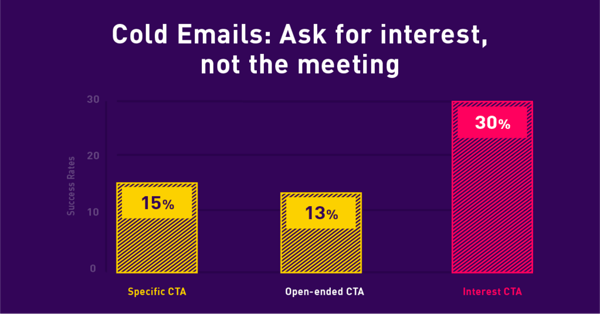
Interest allllll day.
Here are some interest-based cold email call to action examples you can steal (plus plenty more if you click that hyperlink):
- Is [goal] a priority right now?
- Are you happy with your team’s [specific output]?
- Is this something that’s on your radar as well?
- Have you tried this approach before?
- Do you think this would make your life easier?
- [Main pain point] sucks. Do you want it to suck less?
- Open to seeing how it works? (borrowed from Armand Farrokh)
15. Only include one CTA
Getting a reply from your prospect is hard enough as it is, there’s no point in confusing them with multiple calls to action.
Simple is the name of the game when drafting a cold email CTA.
Here’s what Jason had to say about that in the webinar: “When you ask people to do more than one thing, the likelihood of them doing anything at all is extremely low.”
The takeaway here? Only ask them ONE question.
And if you want to reduce friction even more and make it even easier for your recipient to answer your question, you can use an email enhancement like this one that lets you embed a yes/no poll directly in your email.
Mixmax's in-email Poll feature
Bonus tactic: Send your emails at the right time
In cold email outreach, timing is almost as important as content. As a bonus tactic, we'll discuss the significance of sending emails at the right time, an important element of best practices for cold email outreach.
Consider when your prospects are most likely to check their emails, because if you miss the mark, it’s likely to be buried and never seen.
This could vary based on:
- Time zones
- Work schedules
- Industry habits
Tuesday and Thursday mornings are generally good times for sending business emails, with Wednesday a close second.
But you know what’s better than relying on industry averages? Real insights about the best time to send cold emails based on recipient data.
Sorcery? Nah.
You can use a sales engagement platform that uses AI and machine learning to recommend the best times to send your email to a recipient based on their inbox habits.
Here’s what that looks like via Mixmax:
Mixmax’s AI Smart Send feature
Let's wrap this up
Cold emails are a battlefield, and it’s not just about sending more, it’s about sending better. By incorporating these strategies, you'll be embracing effective cold email best practices that can enhance your outreach efforts.
Here’s what you need to take away from this blog:
- Say "No" to cliché subject lines and "Yes" to looking like an internal email. Nothing screams "SPAM!" louder than a sales-y subject line.
- First name at the end of the opening line? Might be strange, but it works. And don’t forget, it's all about them, not you.
- Keeping your body copy clean, simple, and focused on the value props will make your prospects' skimming worthwhile.
- Never underestimate the power of a compelling story. Social proof? Use it. Your prospects want to hear about their peers' success.
- Finally, the CTA. It’s the big finish, the closing number, and it better be good. Interest-based and only one per email, please. Also, don’t ask for a meeting right away; it's a cold email, remember?
- Time your emails right. Tuesday and Thursday mornings are good, but real insights based on recipient data? That’s the sweet spot.
.png?width=750&height=393&name=Social_Webinar%20Modern%20sales%20techniques%20(6).png)
Want to see Jason Bay and Jack Wauson in action? Watch the full webinar recording on non-obvious cold email tactics here.


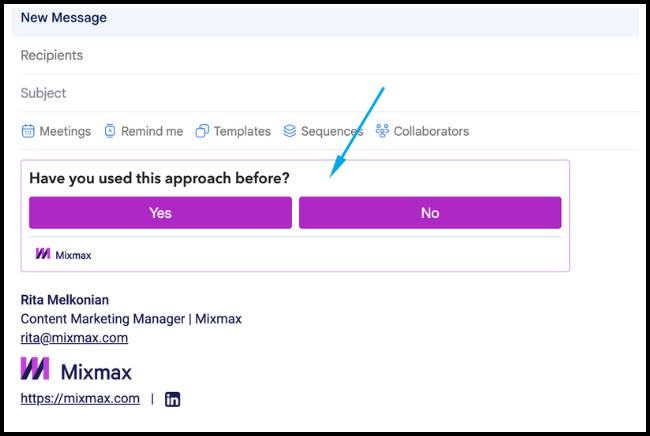


.png?width=450&height=250&name=Episode%20Graphic%20(1).png)
